Blog - greenhouse heat
Heating Your Greenhouse with Renewable Energy
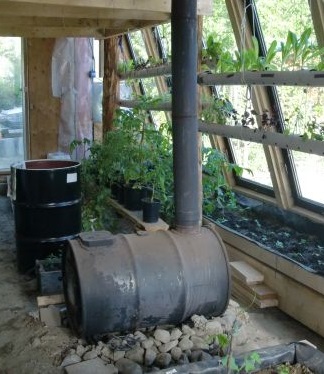 Those of us who live in northern climates know that maintaining minimum temperatures overnight and during the winter months is critical to operating a full year greenhouse without suffering significant, or even the complete, loss of your crops. Even without the threat of loss, the efficiency and effectiveness of your greenhouse will be significantly reduced without the ability to keep nighttime temperatures up during the late winter and early spring months when you are attempting to germinate seeds and protect the tender growth of seedling plants that are just waiting for the right time to be transplanted into your garden.
Those of us who live in northern climates know that maintaining minimum temperatures overnight and during the winter months is critical to operating a full year greenhouse without suffering significant, or even the complete, loss of your crops. Even without the threat of loss, the efficiency and effectiveness of your greenhouse will be significantly reduced without the ability to keep nighttime temperatures up during the late winter and early spring months when you are attempting to germinate seeds and protect the tender growth of seedling plants that are just waiting for the right time to be transplanted into your garden.
Given the importance that providing supplemental heat can have to the return-on-investment that you will be able to realize from your greenhouse, implementing a heating system that can continue to function in a self-reliant manner is important. Relying on grid power or the next delivery of fuel from the area energy company will leave your greenhouse in the cold should the lights go out or fuel costs become unbearable. So, selecting and installing a renewable energy heating system in your greenhouse is your best option toward securing a more independent lifestyle.
Now that you can see the value that adding a renewable energy heating system can provide for your greenhouse investment, I’m going to provide an overview of what I consider to be some of the top system choices for your consideration. Be sure to consider the resources that your property offers in determining which of these systems is the most likely to offer you the most benefit over its lifetime of use.
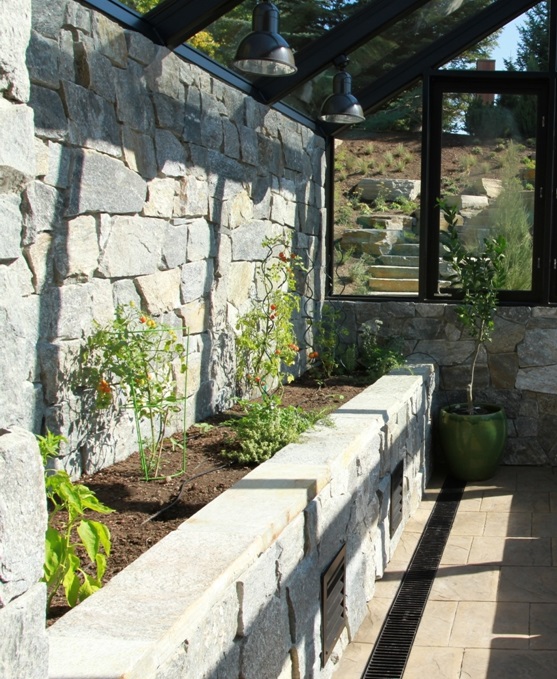 PASSIVE SOLAR/THERMAL MASS HEATING: The basic idea of passive solar / thermal mass heating is to use sunlight to heat high density materials, such as stone, concrete or water (stored in a container) throughout the daytime, which then allows those now heated materials to release that stored heat energy (similar to how a battery stores energy) to the surrounding area throughout the night. This form of renewable energy heating requires the least input of labor and materials over its lifecycle. In order to get the most out of a thermal mass heating system, it is important to locate your high density (mass) materials in places that are in direct sunlight for as much of the daylight hours as possible. It is also important to isolate these materials from the exterior by isolating them with insulation, such as foam, fiberglass, straw or earth. The south face of the north wall of the greenhouse is often the best location for the main thermal mass wall. One of the least expensive ways to create thermal mass along the inside face of a wall is to place black colored containers (such as a 55 gallon drum) filled with water. The dark color of the barrels will be efficient at absorbing energy from the sun and storing it in the high density material of the water. You can also place concrete, rock or bricks as stepping stones throughout the greenhouse. This is a good renewable energy heating option for sunny locations, but especially for those locations that lack wood for fuel. If your region is known for having multiple days of overcast skies in the winter months, this method may not produce enough heat on its own. Locations were direct sunlight can strike the thermal mass material on a regular basis is a critical factor in the successful use of this system.
PASSIVE SOLAR/THERMAL MASS HEATING: The basic idea of passive solar / thermal mass heating is to use sunlight to heat high density materials, such as stone, concrete or water (stored in a container) throughout the daytime, which then allows those now heated materials to release that stored heat energy (similar to how a battery stores energy) to the surrounding area throughout the night. This form of renewable energy heating requires the least input of labor and materials over its lifecycle. In order to get the most out of a thermal mass heating system, it is important to locate your high density (mass) materials in places that are in direct sunlight for as much of the daylight hours as possible. It is also important to isolate these materials from the exterior by isolating them with insulation, such as foam, fiberglass, straw or earth. The south face of the north wall of the greenhouse is often the best location for the main thermal mass wall. One of the least expensive ways to create thermal mass along the inside face of a wall is to place black colored containers (such as a 55 gallon drum) filled with water. The dark color of the barrels will be efficient at absorbing energy from the sun and storing it in the high density material of the water. You can also place concrete, rock or bricks as stepping stones throughout the greenhouse. This is a good renewable energy heating option for sunny locations, but especially for those locations that lack wood for fuel. If your region is known for having multiple days of overcast skies in the winter months, this method may not produce enough heat on its own. Locations were direct sunlight can strike the thermal mass material on a regular basis is a critical factor in the successful use of this system.
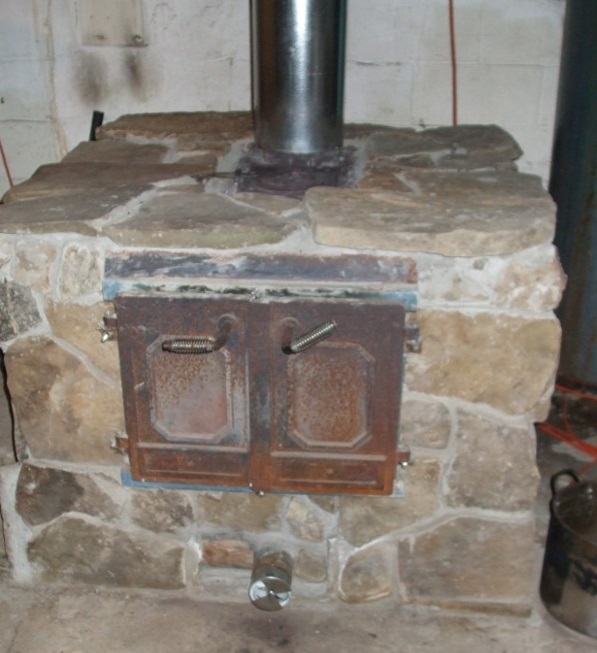 WOODSTOVE HEATERS: Since most people are familiar with the use of woodstoves as a heating source, I will focus this conversation on the importance of using mass around the woodstove. Using a cast iron woodstove is better than steel. In either case, the most important consideration is providing a significant amount of high density materials in close proximity to the woodstove. Similar to the passive solar thermal mass heating approach, placing mass around the woodstove allows these dense materials to absorb the radiated heat from the fire (as compared to the solar heat from sunlight) to warm the mass, and then slowly release it hours after the fire has burned out. Of course, as with all forms of wood heat, this option should only be considered if you have a fuel source readily available on your property.
WOODSTOVE HEATERS: Since most people are familiar with the use of woodstoves as a heating source, I will focus this conversation on the importance of using mass around the woodstove. Using a cast iron woodstove is better than steel. In either case, the most important consideration is providing a significant amount of high density materials in close proximity to the woodstove. Similar to the passive solar thermal mass heating approach, placing mass around the woodstove allows these dense materials to absorb the radiated heat from the fire (as compared to the solar heat from sunlight) to warm the mass, and then slowly release it hours after the fire has burned out. Of course, as with all forms of wood heat, this option should only be considered if you have a fuel source readily available on your property.
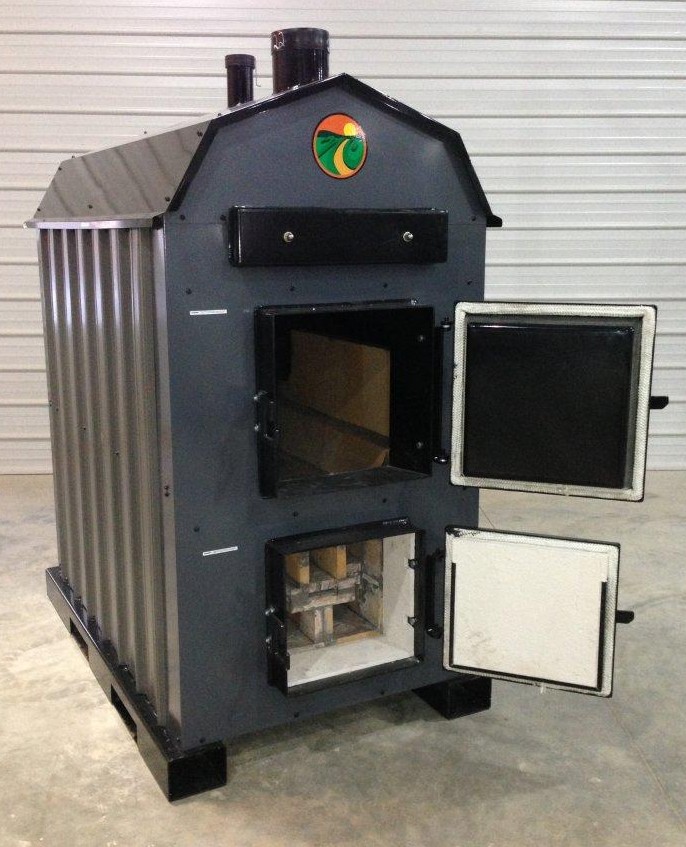 WOOD FIRED BOILERS: These systems are commonly located outside to reduce the risk of fire hazards and minimize the need for constructing a costly flue system within the structure. The ability to heat a hydronic system (piped hot water) using wood offers a very energy efficient and affordable approach. A hydronic system does require the use of electrical power to run circulation pumps, which move the water through the hydronic system piping. The circulation pumps can be run using a solar powered system that make the overall integrated system even more self-sufficient. The heating system can even be configured with one or more zones feeding the greenhouse and other structures. While a hydronic system has more components, which means more potential points of failure, the use of hydronics to provide radiant heat in the soil of the greenhouse offers a nice advantage. Air temperature is important to preventing frost damage and causing plant growth to slow or even stop when temperatures are too low. However, soil temperature is key to seed germination and vigorous plant growth. So using in-ground radiant heat tubing within the greenhouse can maintain both the minimum soil and air temperatures needed for efficient food production. While among the more costly and complex of the greenhouse heating options, a wood fired boiler is worthy of consideration, especially if it is also used to provide heat for your home and/or other needs.
WOOD FIRED BOILERS: These systems are commonly located outside to reduce the risk of fire hazards and minimize the need for constructing a costly flue system within the structure. The ability to heat a hydronic system (piped hot water) using wood offers a very energy efficient and affordable approach. A hydronic system does require the use of electrical power to run circulation pumps, which move the water through the hydronic system piping. The circulation pumps can be run using a solar powered system that make the overall integrated system even more self-sufficient. The heating system can even be configured with one or more zones feeding the greenhouse and other structures. While a hydronic system has more components, which means more potential points of failure, the use of hydronics to provide radiant heat in the soil of the greenhouse offers a nice advantage. Air temperature is important to preventing frost damage and causing plant growth to slow or even stop when temperatures are too low. However, soil temperature is key to seed germination and vigorous plant growth. So using in-ground radiant heat tubing within the greenhouse can maintain both the minimum soil and air temperatures needed for efficient food production. While among the more costly and complex of the greenhouse heating options, a wood fired boiler is worthy of consideration, especially if it is also used to provide heat for your home and/or other needs.
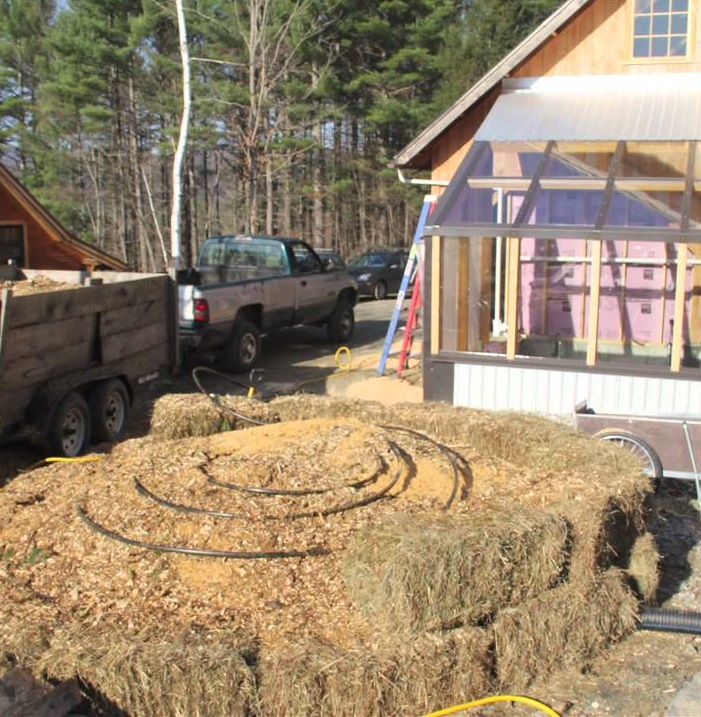 COMPOST HEAT MOUND: This sustainable heat production idea was developed in France by the inventor and innovator Jean Pain. The genius of this system is its simplicity. By creating a large mound of compost material, comprised primarily of wood chips and other common compost materials, the decomposition of this organic material creates new soil and a byproduct of heat. The center of the mound has a continuous length of water filled piping coiled inside. The heat from the mound is transferred to the water in the piping and circulated similar to that of a wood fired boiler hydronic system using a pump. This also means that like the wood fired boiler, the hydronic system can be used to heat the greenhouse using in-ground radiant heating. Locating the mound close to the greenhouse provides an efficient supplemental heat source that also produces a fresh batch of newly composted soil each year that can be used to replenish and enrich the greenhouse soil. This heating method is fairly low cost and can be rather easily sustained if the circulation pump is run using a renewable electricity source and you have access on your property to organic materials that can be used for compost.
COMPOST HEAT MOUND: This sustainable heat production idea was developed in France by the inventor and innovator Jean Pain. The genius of this system is its simplicity. By creating a large mound of compost material, comprised primarily of wood chips and other common compost materials, the decomposition of this organic material creates new soil and a byproduct of heat. The center of the mound has a continuous length of water filled piping coiled inside. The heat from the mound is transferred to the water in the piping and circulated similar to that of a wood fired boiler hydronic system using a pump. This also means that like the wood fired boiler, the hydronic system can be used to heat the greenhouse using in-ground radiant heating. Locating the mound close to the greenhouse provides an efficient supplemental heat source that also produces a fresh batch of newly composted soil each year that can be used to replenish and enrich the greenhouse soil. This heating method is fairly low cost and can be rather easily sustained if the circulation pump is run using a renewable electricity source and you have access on your property to organic materials that can be used for compost.
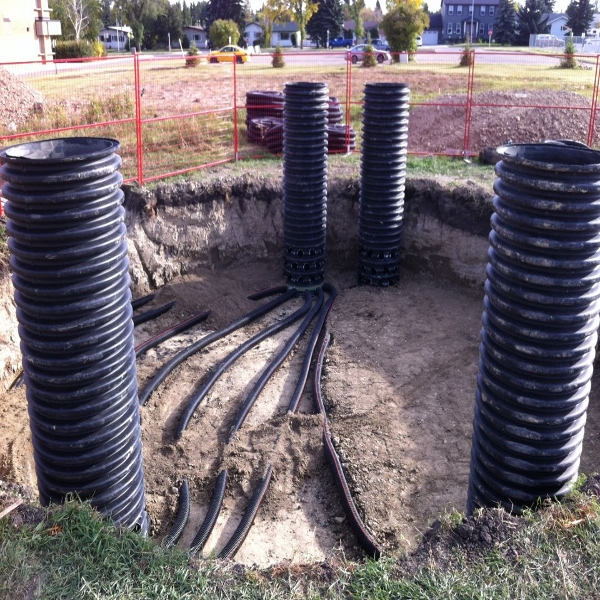 CLIMATE BATTERY: Designed with greenhouse efficiency in mind, a climate battery transfers the heat and moisture from the greenhouse air into the earth where the plant roots are located, allowing the plants to benefit from the increased soil temperature and moisture levels. This is accomplished by installing a series of small perforated pipes horizontally below the soil that manifold together into larger pipes which are set vertically, so that they extend above the surface of the ground. The air in the greenhouse is pushed through these vertical pipes, which forces the warm moist air into the smaller horizontal pipes below the ground. The ground in turn absorbs some of the heat and moisture from the air, making it available to the plant roots. The system is also effective when coupled with aquaponic systems, as they also release large quantities of moisture into the air from both the plant’s process of photosynthesis and the evaporation caused by the exposed surface water of both the aquatic and hydroponic environments. The process of transferring the sun’s energy available during the daytime into the soil so that it can help maintain warmer temperatures overnight helps to overcome heat loss in the winter months when nighttime temperatures can become extremely low. However, the climate battery alone may not supply enough heat in the winter months, so a supplemental heat source may also be needed. This is especially true in regions where sunny days may not occur frequently during the winter months. Also, as the climate battery requires some power to operate fans that circulate the air, feeding it from a renewable electrical power system would be wise. While the climate battery offers many benefits, it is also rather costly to install. Given these considerations, I would look to the climate battery as a secondary system for enhancing the greenhouse environment, not your primary heating system.
CLIMATE BATTERY: Designed with greenhouse efficiency in mind, a climate battery transfers the heat and moisture from the greenhouse air into the earth where the plant roots are located, allowing the plants to benefit from the increased soil temperature and moisture levels. This is accomplished by installing a series of small perforated pipes horizontally below the soil that manifold together into larger pipes which are set vertically, so that they extend above the surface of the ground. The air in the greenhouse is pushed through these vertical pipes, which forces the warm moist air into the smaller horizontal pipes below the ground. The ground in turn absorbs some of the heat and moisture from the air, making it available to the plant roots. The system is also effective when coupled with aquaponic systems, as they also release large quantities of moisture into the air from both the plant’s process of photosynthesis and the evaporation caused by the exposed surface water of both the aquatic and hydroponic environments. The process of transferring the sun’s energy available during the daytime into the soil so that it can help maintain warmer temperatures overnight helps to overcome heat loss in the winter months when nighttime temperatures can become extremely low. However, the climate battery alone may not supply enough heat in the winter months, so a supplemental heat source may also be needed. This is especially true in regions where sunny days may not occur frequently during the winter months. Also, as the climate battery requires some power to operate fans that circulate the air, feeding it from a renewable electrical power system would be wise. While the climate battery offers many benefits, it is also rather costly to install. Given these considerations, I would look to the climate battery as a secondary system for enhancing the greenhouse environment, not your primary heating system.
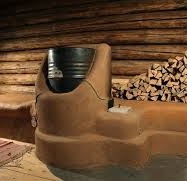 ROCKET MASS HEATERS: A combination between a woodstove and thermal mass heater, the rocket mass heat combines efficient wood burning with a significant amount of high density materials surrounding the firebox and flue to absorb and radiate a significant portion of the heat energy. By using a small firebox, re-burn chamber, and long flue pipe that are surrounded by a mass of high density materials, such as stone, bricks and adobe, these heaters are very energy efficient. The downside is that heating all of that thermal mass with a small firebox can take a significant amount of time. However, once the mass has been thoroughly heated, it will continue to release a significant amount of heat for many hours. While a rocket mass heater can be relatively inexpensive to build, they do require a significant amount of space, so plan accordingly. If you plan the size and layout of your greenhouse to incorporate one of these heating systems, and you have the time to feed the fire until the mass has been thoroughly heated, this is a very efficient system worthy of consideration.
ROCKET MASS HEATERS: A combination between a woodstove and thermal mass heater, the rocket mass heat combines efficient wood burning with a significant amount of high density materials surrounding the firebox and flue to absorb and radiate a significant portion of the heat energy. By using a small firebox, re-burn chamber, and long flue pipe that are surrounded by a mass of high density materials, such as stone, bricks and adobe, these heaters are very energy efficient. The downside is that heating all of that thermal mass with a small firebox can take a significant amount of time. However, once the mass has been thoroughly heated, it will continue to release a significant amount of heat for many hours. While a rocket mass heater can be relatively inexpensive to build, they do require a significant amount of space, so plan accordingly. If you plan the size and layout of your greenhouse to incorporate one of these heating systems, and you have the time to feed the fire until the mass has been thoroughly heated, this is a very efficient system worthy of consideration.
Adding a heat source to your greenhouse can transform it from three season effectiveness to full-year production capability. Gaining those additional months of food production can translate into pounds of additional food. Given that the future cost and/or availability of food purchased from grocery stores is uncertain, enhancing your self-reliant ability to produce food all year long is worthy of your thoughtful consideration and investment now.
Helping you achieve a life of liberty.

© 2023 Strategic Landscape Design
